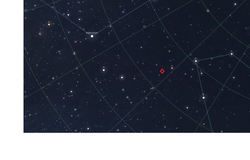| Observation data Epoch J2000.0 Equinox J2000.0 ( ICRS) | |
|---|---|
| Constellation | Draco |
| Right ascension | 20h 08m 05.75515s [1] |
| Declination | +66° 51′ 02.0766″ [1] |
| Apparent magnitude (V) | 8.971 [2] |
| Characteristics | |
| HD 191939 | |
| Evolutionary stage | main sequence |
| Spectral type | G9V [3] |
| Astrometry | |
| Radial velocity (Rv) | −9.23±0.16 [1] km/s |
| Proper motion (μ) |
RA: 150.194±0.015
mas/
yr
[1] Dec.: −63.988±0.017 mas/ yr [1] |
| Parallax (π) | 18.6967 ± 0.0133 mas [1] |
| Distance | 174.4 ± 0.1
ly (53.49 ± 0.04 pc) |
| Absolute magnitude (MV) | 5.32 |
| Details [3] | |
| HD 191939 | |
| Mass | 0.81±0.04 M☉ |
| Radius | 0.94±0.02 R☉ |
| Luminosity (bolometric) | 0.65±0.02 L☉ |
| Surface gravity (log g) | 4.3±0.1 cgs |
| Temperature | 5348±100 K |
| Metallicity [Fe/H] | −0.15±0.06 dex |
| Rotational velocity (v sin i) | 0.6±0.5 [4] km/s |
| Age | 7±3 [4] Gyr |
| Other designations | |
| Database references | |
| SIMBAD | data |
| Exoplanet Archive | data |
HD 191939 is a single yellow ( G-type) main-sequence star, located approximately 174 light-years away in the constellation of Draco, taking its primary name from its Henry Draper Catalogue designation.
Characteristics
HD 191939 is a Sun-like G-type main-sequence star, likely older than the Sun and relatively depleted in metals.
Planetary system
In 2020, an analysis carried out by a team of astronomers led by astronomer Mariona Badenas-Agusti of the TESS project confirmed the existence of three gaseous planets, all smaller than Neptune, in orbit around HD 191939. [4] Another non-transiting gas giant planet designated HD 191939 e was detected in 2021, along with a substellar object on a highly uncertain, 9 to 46 year orbit. [3] In 2022, a sixth planet, with a mass comparable to Uranus, was discovered in the system's habitable zone. [6] The 2021 study also suggested the possible presence of an additional non-transiting planet with a period of 17.7 days, [3] but the 2022 study did not support this. [6]
| Companion (in order from star) |
Mass |
Semimajor axis ( AU) |
Orbital period ( days) |
Eccentricity | Inclination | Radius |
|---|---|---|---|---|---|---|
| b | 10.00±0.70 M🜨 | 0.0804+0.0025 −0.0023 |
8.8803256 | 0.031+0.010 −0.011 |
88.10+0.14 −0.10 ° |
3.410±0.075 R🜨 |
| c | 8.0±1.0 M🜨 | 0.1752+0.0055 −0.0050 |
28.579743 | 0.034+0.034 −0.013 |
89.10+0.06 −0.08 ° |
3.195±0.075 R🜨 |
| d | 2.80±0.60 M🜨 | 0.2132+0.0065 −0.0061 |
38.353037 | 0.031+0.018 −0.012 |
89.49+0.05 −0.08 ° |
2.995±0.070 R🜨 |
| e | ≥112.2±4.0 M🜨 | 0.407±0.012 | 101.12±0.13 | 0.031+0.008 −0.016 |
88.7±0.7 [3] ° | — |
| g | ≥13.5±2.0 M🜨 | 0.812±0.028 | 284+10 −8 |
0.030+0.025 −0.011 |
— | — |
| f | >2.08 MJ | >3.2 | >2200 | — | — | — |
See also
- List of extrasolar planets
- List of exoplanets discovered in 2020 (HD 191939 b, c and d)
- List of exoplanets discovered in 2021 (HD 191939 e)
- List of exoplanets discovered in 2022 (HD 191939 f & g)
References
- ^ a b c d e Vallenari, A.; et al. (Gaia collaboration) (2023). "Gaia Data Release 3. Summary of the content and survey properties". Astronomy and Astrophysics. 674: A1. arXiv: 2208.00211. Bibcode: 2023A&A...674A...1G. doi: 10.1051/0004-6361/202243940. S2CID 244398875. Gaia DR3 record for this source at VizieR.
- ^ "HD 191939 - Star - SKY-MAP". news.sky-map.org.
- ^ a b c d e Lubin, Jack; et al. (2022). "TESS-Keck Survey. IX. Masses of Three Sub-Neptunes Orbiting HD 191939 and the Discovery of a Warm Jovian plus a Distant Substellar Companion". The Astronomical Journal. 163 (2): 101. arXiv: 2108.02208. Bibcode: 2022AJ....163..101L. doi: 10.3847/1538-3881/ac3d38. S2CID 236924440.
- ^ a b c Badenas-Agusti, Mariona; Günther, Maximilian N.; Daylan, Tansu; Mikal-Evans, Thomas; Vanderburg, Andrew; Huang, Chelsea X.; Matthews, Elisabeth; Rackham, Benjamin V.; Bieryla, Allyson; Stassun, Keivan G.; Kane, Stephen R.; Shporer, Avi; Fulton, Benjamin J.; Hill, Michelle L.; Nowak, Grzegorz; Ribas, Ignasi; Pallé, Enric; Jenkins, Jon M.; Latham, David W.; Seager, Sara; Ricker, George R.; Vanderspek, Roland K.; Winn, Joshua N.; Abril-Pla, Oriol; Collins, Karen A.; Pere Guerra Serra; Niraula, Prajwal; Rustamkulov, Zafar; Barclay, Thomas; et al. (2020). "HD 191939: Three Sub-Neptunes Transiting a Sun-like Star Only 54 pc Away". The Astronomical Journal. 160 (3): 113. arXiv: 2002.03958. Bibcode: 2020AJ....160..113B. doi: 10.3847/1538-3881/aba0b5. S2CID 211069628.
- ^ "HD 191939". SIMBAD. Centre de données astronomiques de Strasbourg.
- ^ a b c Orell-Miquel, J.; Nowak, G.; Murgas, F.; Palle, E.; Morello, G.; Luque, R.; Badenas-Agusti, M.; Ribas, I.; Lafarga, M.; Espinoza, N.; Morales, J. C.; Zechmeister, M.; Alqasim, A.; Cochran, W. D.; Gandolfi, D.; Goffo, E.; Kabáth, P.; Korth, J.; Livingston, J.; Lam, K. W. F.; Muresan, A.; Persson, C. M.; Van Eylen, V. (2023). "HD 191939 revisited: New and refined planet mass determinations, and a new planet in the habitable zone". Astronomy & Astrophysics. 669: A40. arXiv: 2211.00667. Bibcode: 2023A&A...669A..40O. doi: 10.1051/0004-6361/202244120. S2CID 253197272.






